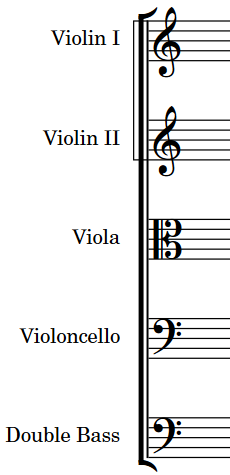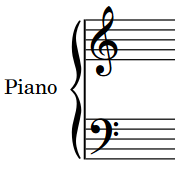Brackets and braces
Brackets and braces are thick straight and curved lines in the left-hand margin that show instrument groupings.
Brackets
A bracket is a thick black line, the width of a beam, that groups staves together, most commonly according to instrument family. It often has winged ends that point inwards towards the score.
It is always positioned directly to the left of a systemic barline. If secondary brackets are used in addition to a bracket, they are positioned further away from the start of the system to allow space for the bracket.

Figure: An example of a bracket, connecting instruments in the string family. A sub-bracket connects the two violin lines.
In Dorico, barlines join the same staves that are joined by brackets and braces, meaning that a bracketed group of staves or a braced pair of staves appears with barlines extending across the group.
Braces
A brace is a wavy or curly line that joins multiple staves belonging to the same instrument, such as the piano or harp. If necessary, a brace can extend to three or more staves, although two is most common.
The brace is also sometimes used instead of a sub-bracket to show groupings of identical instruments within a family whose staves are joined by a bracket.
It is positioned outside the systemic barline, and if used in place of a sub-bracket, outside of the bracket as well.

Figure: A brace connecting two piano staves